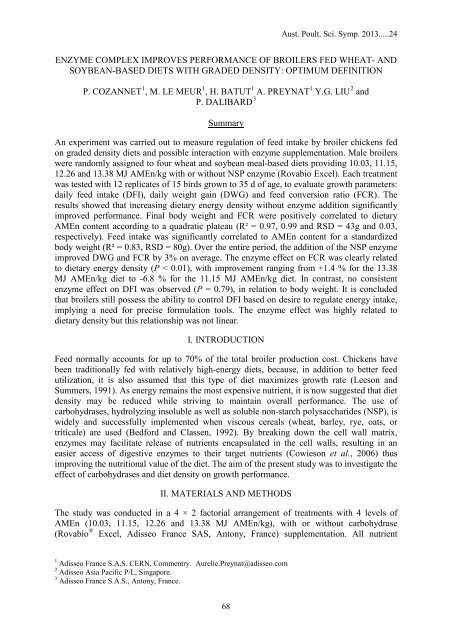APSS 2013 Proceedings - The University of Sydney
APSS 2013 Proceedings - The University of Sydney
APSS 2013 Proceedings - The University of Sydney
Create successful ePaper yourself
Turn your PDF publications into a flip-book with our unique Google optimized e-Paper software.
Aust. Poult. Sci. Symp. <strong>2013</strong>.....24<br />
ENZYME COMPLEX IMPROVES PERFORMANCE OF BROILERS FED WHEAT- AND<br />
SOYBEAN-BASED DIETS WITH GRADED DENSITY: OPTIMUM DEFINITION<br />
P. COZANNET 1 , M. LE MEUR 1 , H. BATUT 1 A. PREYNAT 1 Y.G. LIU 2 and<br />
P. DALIBARD 3<br />
Summary<br />
An experiment was carried out to measure regulation <strong>of</strong> feed intake by broiler chickens fed<br />
on graded density diets and possible interaction with enzyme supplementation. Male broilers<br />
were randomly assigned to four wheat and soybean meal-based diets providing 10.03, 11.15,<br />
12.26 and 13.38 MJ AMEn/kg with or without NSP enzyme (Rovabio Excel). Each treatment<br />
was tested with 12 replicates <strong>of</strong> 15 birds grown to 35 d <strong>of</strong> age, to evaluate growth parameters:<br />
daily feed intake (DFI), daily weight gain (DWG) and feed conversion ratio (FCR). <strong>The</strong><br />
results showed that increasing dietary energy density without enzyme addition significantly<br />
improved performance. Final body weight and FCR were positively correlated to dietary<br />
AMEn content according to a quadratic plateau (R² = 0.97, 0.99 and RSD = 43g and 0.03,<br />
respectively). Feed intake was significantly correlated to AMEn content for a standardized<br />
body weight (R² = 0.83, RSD = 80g). Over the entire period, the addition <strong>of</strong> the NSP enzyme<br />
improved DWG and FCR by 3% on average. <strong>The</strong> enzyme effect on FCR was clearly related<br />
to dietary energy density (P < 0.01), with improvement ranging from +1.4 % for the 13.38<br />
MJ AMEn/kg diet to -6.8 % for the 11.15 MJ AMEn/kg diet. In contrast, no consistent<br />
enzyme effect on DFI was observed (P = 0.79), in relation to body weight. It is concluded<br />
that broilers still possess the ability to control DFI based on desire to regulate energy intake,<br />
implying a need for precise formulation tools. <strong>The</strong> enzyme effect was highly related to<br />
dietary density but this relationship was not linear.<br />
I. INTRODUCTION<br />
Feed normally accounts for up to 70% <strong>of</strong> the total broiler production cost. Chickens have<br />
been traditionally fed with relatively high-energy diets, because, in addition to better feed<br />
utilization, it is also assumed that this type <strong>of</strong> diet maximizes growth rate (Leeson and<br />
Summers, 1991). As energy remains the most expensive nutrient, it is now suggested that diet<br />
density may be reduced while striving to maintain overall performance. <strong>The</strong> use <strong>of</strong><br />
carbohydrases, hydrolyzing insoluble as well as soluble non-starch polysaccharides (NSP), is<br />
widely and successfully implemented when viscous cereals (wheat, barley, rye, oats, or<br />
triticale) are used (Bedford and Classen, 1992). By breaking down the cell wall matrix,<br />
enzymes may facilitate release <strong>of</strong> nutrients encapsulated in the cell walls, resulting in an<br />
easier access <strong>of</strong> digestive enzymes to their target nutrients (Cowieson et al., 2006) thus<br />
improving the nutritional value <strong>of</strong> the diet. <strong>The</strong> aim <strong>of</strong> the present study was to investigate the<br />
effect <strong>of</strong> carbohydrases and diet density on growth performance.<br />
II. MATERIALS AND METHODS<br />
<strong>The</strong> study was conducted in a 4 × 2 factorial arrangement <strong>of</strong> treatments with 4 levels <strong>of</strong><br />
AMEn (10.03, 11.15, 12.26 and 13.38 MJ AMEn/kg), with or without carbohydrase<br />
(Rovabio ® Excel, Adisseo France SAS, Antony, France) supplementation. All nutrient<br />
1 Adisseo France S.A.S. CERN, Commentry. Aurelie.Preynat@adisseo.com<br />
2 Adisseo Asia Pacific P/L, Singapore.<br />
3 Adisseo France S.A.S., Antony, France.<br />
68
















